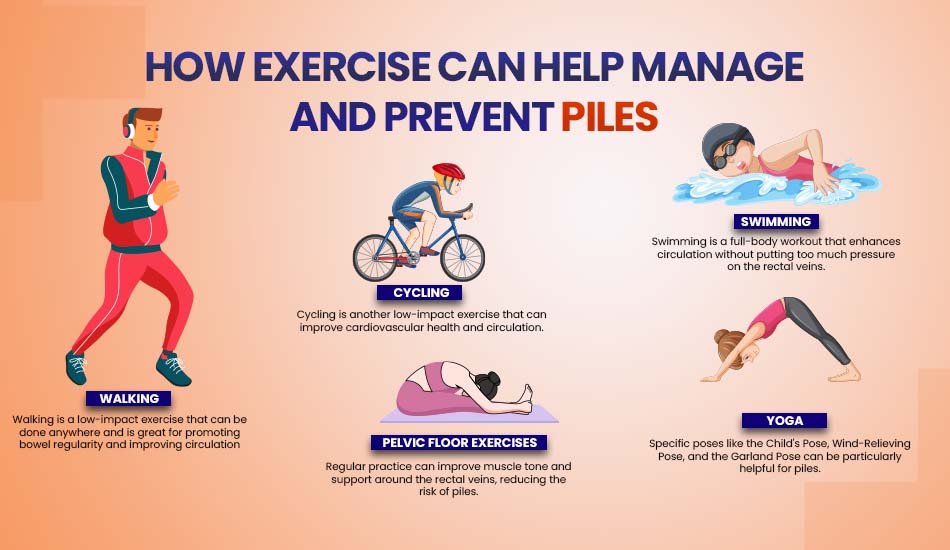
How Exercise Can Help Manage and Prevent Piles
Wednesday, 5th June 2024Piles, also known as hemorrhoids, can be an uncomfortable and painful condition. While dietary changes are crucial for prevention and management, incorporating regular exercise into your routine can also make a significant difference. Here's how exercise can help you manage and prevent piles.
1. Promotes Regular Bowel Movements
Regular physical activity helps stimulate bowel function and promotes regular bowel movements. This can reduce the risk of constipation, a major cause of piles. Activities like walking, jogging, and yoga can help keep your digestive system moving.
2. Reduces Pressure on Rectal Veins
Exercise helps maintain a healthy weight, which in turn reduces pressure on the rectal veins. Excess weight can increase the likelihood of developing piles. By staying active and managing your weight, you can minimize the pressure on these veins and lower your risk.
3. Improves Circulation
Good circulation is essential for preventing piles. Exercise boosts blood flow throughout your body, including the rectal area. Improved circulation helps prevent blood from pooling in the veins, reducing the risk of swelling and the formation of piles.
4. Strengthens Muscles
Certain exercises can help strengthen the muscles around the rectum and anus. Stronger muscles provide better support for the veins in this area, reducing the risk of them becoming swollen. Kegel exercises, for example, can be particularly beneficial for strengthening the pelvic floor muscles.
5. Reduces Stress
Stress can negatively impact your digestive system and contribute to conditions like constipation, which can lead to piles. Regular exercise is an excellent way to reduce stress levels. Activities such as yoga, tai chi, and even a daily walk can help lower stress and promote better overall health.
6. Encourages Healthy Lifestyle Choices
People who exercise regularly are more likely to make healthier lifestyle choices in other areas, such as diet and hydration. These combined efforts can significantly reduce the risk of developing piles and improve overall digestive health.
Best Exercises to Prevent and Manage Piles
Walking
Walking is a low-impact exercise that can be done anywhere and is great for promoting bowel regularity and improving circulation. Aim for at least 30 minutes of brisk walking each day.
Yoga
Yoga helps improve flexibility, reduce stress, and strengthen the muscles around the rectum and anus. Specific poses like the Child's Pose, Wind-Relieving Pose, and the Garland Pose can be particularly helpful for piles.
Swimming
Swimming is a full-body workout that enhances circulation without putting too much pressure on the rectal veins. It’s an excellent option for those who may find high-impact exercises uncomfortable.
Pelvic Floor Exercises
Also known as Kegel exercises, these are designed to strengthen the pelvic floor muscles. Regular practice can improve muscle tone and support around the rectal veins, reducing the risk of piles.
Cycling
Cycling is another low-impact exercise that can improve cardiovascular health and circulation. However, it’s important to ensure your bike seat is comfortable and doesn’t put too much pressure on the rectal area.
Tips for Exercising with Piles
- Start Slow: If you’re new to exercise or haven’t been active in a while, start with low-impact activities and gradually increase intensity.
- Stay Hydrated: Drink plenty of water before, during, and after exercise to help prevent constipation.
- Listen to Your Body: If you experience pain or discomfort while exercising, stop and consult a healthcare professional.
Why Choose Shriram Hospital for Piles Treatment?
At Shriram Hospital, we offer comprehensive care for piles, including guidance on lifestyle and exercise. Our specialists can help you create a tailored exercise plan that complements your treatment and promotes better health.
Conclusion
Exercise is a powerful tool in the management and prevention of piles. By incorporating regular physical activity into your routine, you can improve bowel function, reduce pressure on rectal veins, and enhance overall health. For expert advice and treatment, reach out to the specialists at Shriram Hospital.


